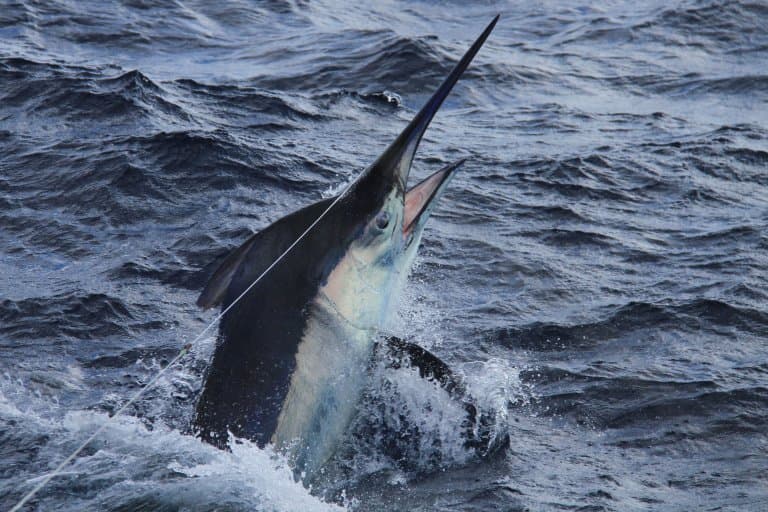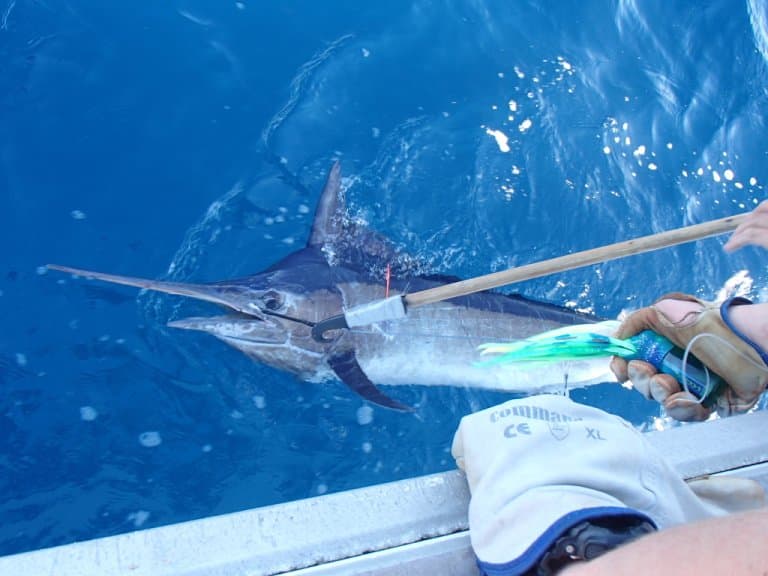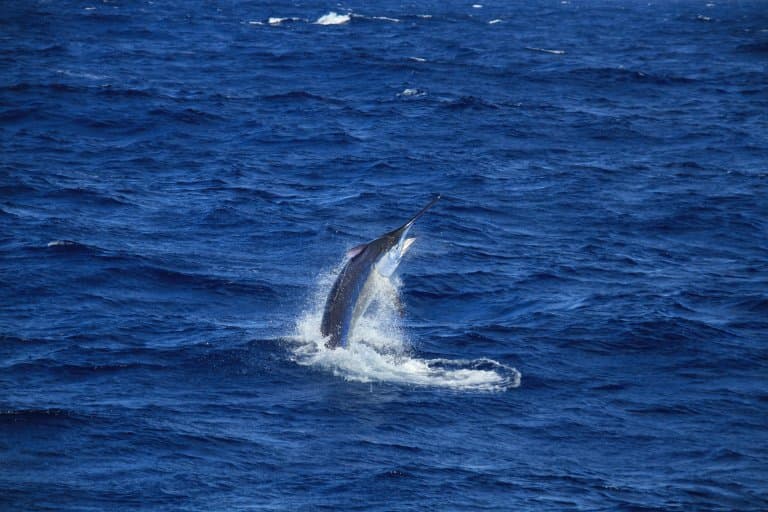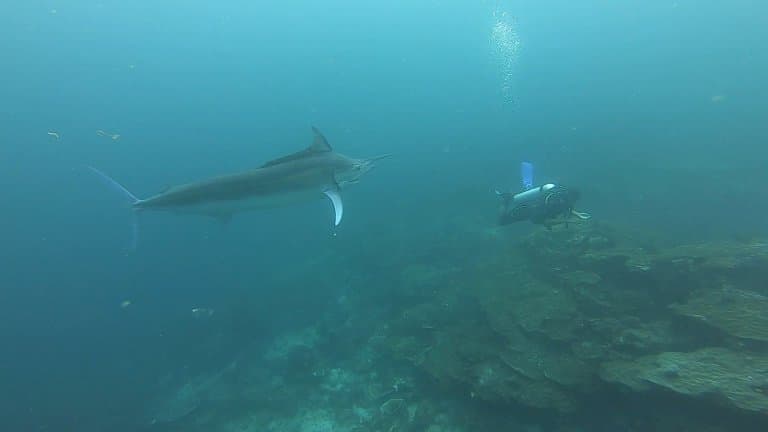Black Marlin Profile
Billfish are enigmatic, speedy, torpedo-like hunters that have been popular among sport fishermen for their raw power, and for coastal communities for their enormous amount of dense, edible muscle.
Of them all, the swordfish is likely the most well-known, but its cousin the marlin is no stranger, either.
There are five genera of marlin, and one, Istiompax, contains a single, elusive member: the black marlin.
It’s one of the largest marlin, and one of the largest bony fish, that inhabit the tropical and subtropical waters of the Indian and Pacific oceans.

Black Marlin Facts Overview
| Habitat: | Tropical, coastal waters |
| Location: | Indian and Pacific oceans |
| Lifespan: | 11 years |
| Size: | Up to 4.65 m (15 ft) |
| Weight: | 1,650 lbs (700 kg) |
| Color: | Dark blue-black and silver |
| Diet: | Fish |
| Predators: | None |
| Top Speed: | 36 kph (22 mph) |
| No. of Species: |
1 |
| Conservation Status: |
Data deficient |
These fish are among the fastest in the ocean, although speeds are often exaggerated. Black marlins are powerful and can grow up to 4.65 m in length and weigh as much as 1,650 lbs (700 kg).
The black marlin is known from its stomach contents to feed mostly in coastal waters. They diet on fish, such as tuna, mackerel and flying fish, as well as squid and octopus.
It’s a highly migratory species, and as a result, little is known about how many there are, or what they get up to out there.
This causes problems for conservationists, who believe that overfishing is threatening their populations, but can’t provide the hard data to back these claims up and push for better protections.
Interesting Black Marlin Facts
1. They are not actually black
While they might be named the black marlin, they aren’t actually black in color. Their top half is a dark blue, while the lower half of the fish is grey-white.
They have feint blue stripes, a brownish dorsal fin and dark pectoral fins.

2. Not so fast!
One of the most popular myths about marlins, and sport fish in general, relates to how fast they are.
Unfounded claims of sprints into the triple digits (both km/h and mph, depending on where you look), are dotted about on less conscientious animal blogs and fishing sites. And as biases go, sport fisher-folk are the most notorious.
However, this is a fast fish. It’s highly muscular and very strong. The trouble is, the ocean is dense. Much denser than air, and this causes more drag.
So, the faster you want to go, there is a need for exponentially more strength to overcome this drag.
Drag does seem to cause upper limits to how fast something can move through water, and when combined with studies into the muscle physiology of various fast-moving fish, researchers concluded that this upper limit is going to be around 36km/h, or 22mph.
The top speed found in the sailfish (supposedly the fastest fish) was around 30kmph / 19mph, so it’s likely the black marlin is around this speed, or less.
Almost certainly not three or four times this speed, as is commonly claimed. 1
3. They have no predators
Being able to move at close to the hard speed limit in the ocean does make it a simple task to escape predation.
Black marlins, once they reach maturity, have no known predators – there’s just nothing big enough that can catch them.
They’re also huge and powerful. With a reliably-recorded maximum weight of around 750kg, this is a lot of fish, and no easy fight, even for the ocean’s top hunters.
This speed and power are what makes them a popular sport fish, but it also makes them slippery customers for marine biologists.
Trying to find and study these animals is a battle against many factors, not least their physical prowess, and as a result, they’re listed as Data Deficient by the IUCN.
4. They enjoy tuna
There isn’t a lot of vegetation in the ocean, so unlike on land, you find that almost everything is a predator of some kind. One of the most formidable bony fish predators is the tuna fish.
While you may know it from the tinned flakes you find on the shelf, tuna come in sizes that almost rival the black marlin, but the skipjack tuna, a medium-sized model, is roughly a meter long and up to about 35kg.
And still, it’s no match for the black marlin. Skipjack tuna, along with some shark species, appears to be an important part of the diet for these fish, and they travel along vast migratory paths to meet them. 2
5. Marlin use their ‘sword’ to stun prey
The sword, called a rostrum is not typically used for stabbing or piercing their prey, instead they use it to slash and stun fish, before feeding on them.
Often they will swim through schools of fish, slashing with their sword, and returning to find injured or stunned prey.
Black marlin will ingest their prey whole, without chewing. Their digestive system breaks down their preys muscle, bones and skin.

6. They have rigid pectoral fins
Black marlin differs from all other marlin species by having rigid pectoral fins that do not retract, and cannot be pressed flat against their sides. However, these pectoral fins can be tilted further backwards for reduced drag when swimming at high-speed.
Their dorsal fin is also the shortest of all billfish, at around half the height of its body. It’s high at the front and dips downward to the back, which differs to a sailfish which extends all the way back.
Researchers are able to count the growth rings on their spine of their dorsal fins to determine their age.
7. Females can release 32 million eggs at a time
External fertilization is used by black marlin to reproduce. As a result, females lay millions of eggs, which males fertilize.
Larval fish emerge and begin to fend for themselves, and both the male and female black marlin are relieved of any parental responsibilities!
The majority of the eggs will go unfertilized and will be eaten by fish and sea creatures.

8. Their migration is cause for concern
When counting fish populations, the simplest way is to either use sonar or a fishing line to get an estimate of the number of animals in a particular area.
And this works well as a count for animals that don’t move much, but in migratory animals, you may find that by the time you’ve finished counting in Taiwan and made your way over to Kenya, it could be the same fish there to meet you.
So, researchers may end up counting them twice and concluding that there are plenty more fish in the sea than there actually are.
And this is an issue with marlin. They’re highly migratory and difficult to follow. This makes it hard to know how badly affected they are by overfishing.
Black marlin can move upwards of 125km per day and occupy any depth from the surface to about 250 meters, so they’re not easy to pin down.
Tagging caught fish solves some of this issue, but again, they’re not easy to catch, so we still don’t know as much as we’d like to about the conditions of their populations. 3
9. Study methods for conservation are hard to come by
One way to help protect an animal’s population is to figure out where and when they’re most vulnerable.
One way to identify where they’re spawning is to find the gravid females. These females have been found to contain up to 32 million eggs, and the closer to this upper bound they are, the higher the likelihood that you’re entering a spawning zone.
Following these data to determine location and season, it should be a simple matter to restrict fishing in these regions and during these periods, to allow populations to recover.
It should be, but it isn’t. 4

10. Fish markets hold valuable data
While NOAA fisheries forbid offering, selling, controlling or owning black marlin as part of the Billfish Conservation Act, the species is still widely found in restaurants outside of the jurisdiction of these regulations.
The Indian Ocean is a particular hotspot for black marlin fishing, and without adequate data on their migratory patterns or even their population conditions, it’s very hard to put the argument forward to stop these practices.
Black marlin is so common in Taiwan that researchers were able to take samples of 923 dorsal fins for their research from a local fish market. They used these fins to establish the age and sex of the fish and correlate these to their sizes. 5
Black Marlin Fact-File Summary
Scientific Classification
| Kingdom: | Animalia |
| Phylum: | Chordata |
| Class: | Actinopterygii |
| Order: | Istiophoriformes |
| Family: | Istiophoridae |
| Genus: | Istiompax |
| Species Name: |
Istiompax Indica |
Fact Sources & References
- Morten B. S. Svendsen, Paolo Domenici, Stefano Marras, Jens Krause, Kevin M. Boswell, Ivan Rodriguez-Pinto, Alexander D. M. Wilson, Ralf H. J. M. Kurvers, Paul E. Viblanc, Jean S. Finger, John F. Steffensen (2016), “Maximum swimming speeds of sailfish and three other large marine predatory fish species based on muscle contraction time and stride length: a myth revisited“, Biol Open.
- Shimose, T., Yokawa, K., Saito, H. et al (2007), “Seasonal occurrence and feeding habits of black marlin, Istiompax indica, around Yonaguni Island, southwestern Japan“, Ichthyol Res.
- Christoph A. Rohner et al (2021), “Movement ecology of black marlin Istiompax indica in the Western Indian Ocean“, Fish Biology.
- Sun, Chi-Lu; Chang, Hsiao-Yun; Liu, Tsung-Yun; Yeh, Su-Zan; Chang, Yi-Jay (2015), “Reproductive biology of the black marlin, Istiompax indica, off southwestern and eastern Taiwan“, Fisheries Research.
- Office of Sustainable Fisheries (2022), “Billfish Conservation Act“, NOAA Fisheries.
